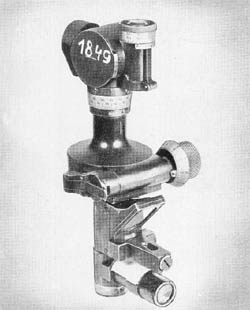 The Panoramic Telescope Rbl. F. 16, which has been replaced by the Rbl. F. 32 and 36, is still used on the
The Panoramic Telescope Rbl. F. 16, which has been replaced by the Rbl. F. 32 and 36, is still used on the
The Model 16/18, shown herewith, is very similar to the 16.
German: p. 182 (June 1, 1945)
 The Panoramic Telescope Rbl. F. 16, which has been replaced by the Rbl. F. 32 and 36, is still used on the
The Panoramic Telescope Rbl. F. 16, which has been replaced by the Rbl. F. 32 and 36, is still used on the
The Model 16/18, shown herewith, is very similar to the 16.
German: p. 182 (June 1, 1945)
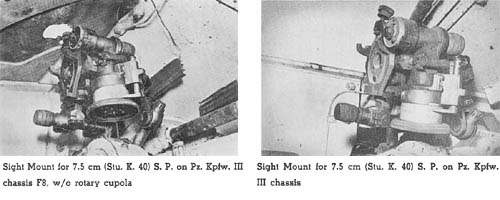
RANGE SCALES: In the above sight mounts there are four scales engraved about the periphery of a vertical range drum. The first scale, used for the Pzgr. 40, is graduated from -300 to 1400 meters; the second for the Spr. is graduated from 100 to 3300 meters, and the third for the Pzgr. 39, is graduated from 200 to 2400 meters. The fourth scale on the drum is a micrometer for the elevation scale located immediately to the right and above the telescope bracket. The elevation scale is graduated in units of 100 mils from 0 to 500.
MOUNTS: The telescope mount for the 7.5 cm Stu. K. 40 is attached to a bracket to the left of the weapon and is connected by a linkage bar so that elevation of the weapon is relayed to the telescope mount. The mount does not automatically compensate for trunnion cant. The telescope used with mounts of this type is of periscopic design and has a removable head. Quadrant elevation is obtained by placing the range drum index in agreement with the proper scale and depressing the telescope mount through the super-elevation angle necessary for the range and then elevating the gun until the apex of the triangle on the telescope reticle is superimposed on the target. There is no angle of site mechanism on the telescope mount, nor is there a longitudinal level vial or index arm to indicate when the gun has been moved through an angle equal to the original movement of the telescope mount. Deflection is introduced by operating the knurled knob at the top-right of the instrument. The deflection scale is graduated in increments of one mil from 0 to 20 on each side of zero.
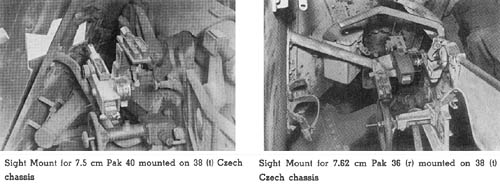
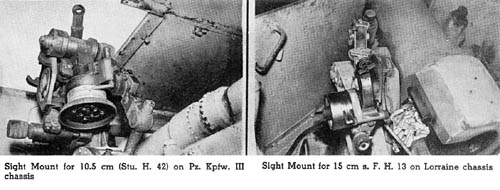
Sight Mount for 10.5 cm (Stu. H. 42) on Pz. Kpfw. III chassis.
RANGE SCALES: There are three scales engraved above the range drum: the top scale is the elevation micrometer for the elevation scale which is graduated from 0 to 300 mils; the next, a range scale, used with the Spr. F. H. Gr., is graduated from 100 to 3300 meters; and the third scale, for the 10.5 cm Gr. 39 HL/A, HL 18, is graduated from 400 to 1500 meters.
MOUNT: The telescope mount for the 10.5 cm Stu. H. 42 is basically the same as the telescope mount for the 7.5 cm Stu. K. 40. The principles of operation are identical.
Sight Mount for 15 cm s. F. H. 13 on Lorraine chassis.
RANGE DRUM: The range drum is quite broad, but there are only two scales on it. The first is a range scale graduated from 100 to 8150 meters. The inner scale is engraved from 0 to 800 mils in 2 mil steps. An elevation scale graduated in units of 100 mils is engraved on a plate fastened to the left trunnion bearing. This scale in conjunction with a pointer actuated by the gun trunnion indicates the angle of elevation imparted to the gun.
MOUNT: The telescope mount for the 15 cm s. F. H. is not an azimuth compensating type. A panoramic telescope bracket is attached to a rack gear and is moved through vertical angles by operation of the knurled knob in the center of the range drum. Angle of site is introduced by turning a wing nut immediately below the telescope bracket. The angle of site scale is engraved about a spiral groove cut into a plate; the index is fitted with a lug that fits in the groove and raises up or down as the scale is turned. Operation of the angle of site mechanism when the range mechanism is locked causes the panoramic telescope to be tilted through an angle equal and opposite to the angle of site. The mount is cross-leveled by turning the wing nut below and forward of the range drum. There is no level vial to indicate a horizontal plane.
German: p. 179, 180, 181
7.5 cm Pak 41
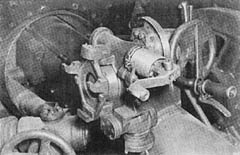
Sight Mount for 7.5/5.5 cm A.T. Gun
RANGE SCALES: There are five scales engraved about the periphery of the range drum. The first is an elevation scale graduated from 0 to 80 mils. The other four are range scales, numbered from 0 to III and graduated from 0 to 4200, 3800, 3400, and 3200 meters respectively. The range scale on the sector is graduated for ranges from 0 to 1500 meters.
TELESCOPE MOUNT: The telescope mount for the 7.5/5.5 is of simple construction. There is a range drum with its axis parallel to the axis of the telescope and a range scale inscribed on an arc that is located on the right side of the telescope mount. A deflection mechanism is located below the range setting handle.
8.8 cm Pak 43/41
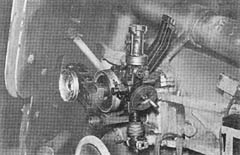
Sight Mount for 8.8 cm A.T. Gun
RANGE DRUM GRADUATION: The range drum has three scales engraved about its periphery. These scales, from left to right are: an elevation scale in steps of 2 mils from 0 to 800; a range scale marked for 8.8 cm Sp. Gr. L/4.7 with limits of 0 to 5500 meters; and a range scale marked 8.8 cm Sp. Gr. 39H1 with limits of 0 to 3000 meters.
TELESCOPE MOUNTS: There are two telescope mounts mounted side by side on the left side of the weapon. The first telescope mount is of the rocking bar type and is designed primarily for anti-tank use. There is no deflection mechanism apparent on the available model. The range drum is graduated from 0 to 4000 meters. The second telescope mount is of the same general design as that used with the 7.5 cm, 10.5 cm and 15 cm howitzers. Both its use and operation are also the same.
German: p. 178
MOUNTS: The telescope mounts of all three howitzers are of the same basic design. All are of the azimuth compensating type and automatically compensate for trunnion cant when cross-levelled. The angle of site mechanism has a scale graduated from 100 to 500 mils with 300 mils representing normal.
OPERATION: Range or super-elevation is introduced by turning the large handwheel below the bracket for the panoramic telescope. Operation of this knob causes the range drum to be rotated past the index and the index arm to be moved through an angle equal to super-elevation.
Angle of site is introduced by two operations. The first operation is to offset the angle of site level vial an amount equal and opposite to the angle of site. This is done by turning the small knob between the super-elevation handwheel and panoramic telescope bracket. The second operation is to rotate the telescope mount by means of the knurled knob beneath the super-elevation handwheel until the angle of site level is again on a horizontal plane. This second step moves the index arm an additional amount and positions it in an angle equal to quadrant elevation.
The second index arm which is actuated by the gun is brought into agreement with the first index arm by elevating the gun. The gun is then laid for quadrant elevation.
It is necessary to operate the angle of site mechanism on the panoramic telescope to bring the line of sight back on its original plane.
7.5 cm le. F. K. 18
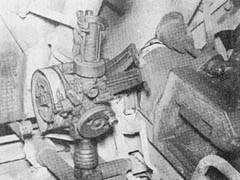
Sight Mount for 7.5 cm Howitzer
RANGE DRUM GRADUATION: The range drum above has two scales: an elevation mil scale numbered from 0 to 800, divided into two mil units, and a range scale graduated in hectometers and numbered from 1 to 15.
10.5 cm le. F. H. 18
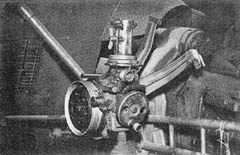
Sight Mount for 10.5 cm Howitzer
RANGE DRUM GRADUATION: The mil scale on the range drum for the above instrument is graduated in the same manner as for the 7.5 cm howitzer. The range scale is graduated for zone 5; the scale is divided into 50 meter units from 100 to 9150 meters.
15 cm s. I. G. 33
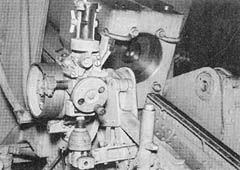
Sight Mount for 15 cm Howitzer
RANGE DRUM GRADUATION: In addition to the 0 to 800 mil scale on the above instrument there is a second mil scale, filled with red, placed to the right of the 0-800 scale. This second scale is graduated in 2 mil steps from 800 to 1330 mils. The range scale is preceded by the Roman Numeral I and is divided in increments of 25 meters from 25 to 1475 meters.
German: p. 177
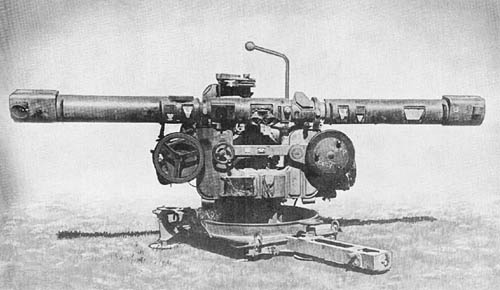
The Kommando-Gerät 36 is a goniographic director, thus differing from directors which operate on plan prediction or angular travel methods. The present instrument measures target course and speed and solves the problem by setting up to scale in ground plan the various distances involved. Ballistic data are obtained from graphical drums; varying heights are accepted, and corrections can be applied for wind, drift, displacement, dead time, and variations in muzzle velocity.
The instrument which has a built-in range finder is large and heavy and has a 4-wheeled traveling carriage for mobile use. A crew of thirteen men is required to operate it.
Readings must be called out to the appropriate operator on the director. Information is passed from one operator to another by voice and via a telephone system.
The instrument is manufactured by Zeiss and displays excellent workmanship. This director, however, has been criticized by fire control experts for poor coordination of basic design and for the excessive number of men needed to operate it.
German: p. 175
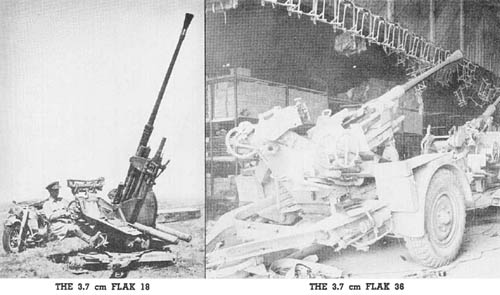
The performance of both the Flak 18 and the Flak 36 are approximately the same, the latter being the lighter and the more mobile version. The weapon is transported on a trailer; the chassis consisting of a “U” shaped steel frame mounted on two pneumatic tires. The weapon and its firing mount may be detached from the chassis by the aid of two winches. In firing position the mount rests on three adjustable firing pads. There are three seats provided; two for the gun pointers and one for the ammunition loader.
The gun has a monobloc tube. The firing mechanism is operated by recoil and residual pressure of gas in a manner similar to the 2 cm Flak 38.
The recoil mechanism is located inside the trough-shaped cradle with the buffer above and the recuperator below. Traversing and elevating mechanisms are operated by handwheels; the former providing a 360° traverse with 35 1/2 turns, and the latter giving a rate of about 4° for each turn. The gun is fired by means of a foot pedal connected to the trigger by a system of levers.
Armor-piercing ammunition is provided in addition to the regular high explosive ammunition, permitting the guns to be employed as antitank weapons.
SPECIFICATIONS
| Caliber | 37 mm (1.45 ins.) | |
| Weight (traveling position) | Flak 36—5,290 lbs. | |
| Weight (firing position) | Flak 36—3,430 lbs. | |
| Length of piece (including flash hider) | 129 ins. | |
| Length of rifling | 71 ins. | |
| Height of trunnions | 44 ins. | |
| Width (overall) | ||
| Length of bore | ||
| No. of grooves | 20—R.H. plain section, | |
| Twist, increasing (1 in 50 to 1 in 40) | ||
| Width of grooves | 0.197 in. | |
| Depth of grooves | 0.02 in. | |
| Width of lands | 0.08 in. | |
| Muzzle velocity (H.E. Shell) | 2,610 f/s* | |
| Max. range (vertical) | 13,775 ft.* | |
| Max. range (horizontal) | 7,080 yds.* | |
| Effective ceiling | 5000 ft.* | |
| Rate of fire (practical) | 80 r.p.m. | |
| Traverse | 360° | |
| Elevation | 85° | |
| Depression | -5° | |
| Length of recoil | ||
| Ammunition | A.P., H.E. | |
| Wt. of projectile | A.P.—1.5 lb. | |
| H.E.—1.4 lb. |
*Not verified.
German: p. 130.1 (August 1, 1945)
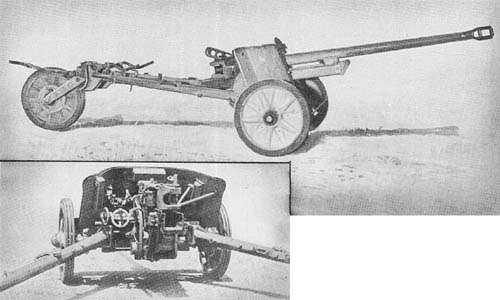
The 5 cm Pak 38, introduced during the 1941 campaigns in Greece and Egypt, was developed to combat the more heavily armored vehicles of the Allies.
The gun has a barrel of monobloc construction, threaded at the muzzle for attaching a two-baffled muzzle brake. Because of the position of the breech-operating cam, a minimum length of recoil of approximately 18 1/2 inches is needed to operate the semi-automatic breech mechanism which is of the sliding horizontal block type. The recoil recuperator system is hydropneumatic.
The carriage, constructed of welded steel, is mounted on metal disk wheels with solid rubber tires. Torsion bar suspension is automatically locked when the tubular trails are spread. A 5 mm spaced armor shield and single apron protect the gun crew. The left side of the shield has a sighting port.
There are five types of ammunition fired from the Pak 38: an armor-piercing capped, high-explosive projectile; a high-explosive shell; an A.P.-H.E. (uncapped) shell; a tungsten carbide core arrowhead type projectile (A.P. 40), and a stick grenade similar to the 3.7 cm grenade described on page 306.
SPECIFICATIONS
| Caliber | 50 mm (1.97 ins.) | |||
| Weight (complete) | 2,015 lbs. (approx.) | |||
| Length of gun (overall) | 15 ft., 3 ins. | |||
| Length of barrel (overall) | 9 ft., 3 ins. | |||
| Width C-C | 5 ft., 1 in. | |||
| Carriage | Welded steel w/solid rubber tires and tubular trails | |||
| Breech mechanism | Horizontal sliding block | |||
| Recoil mechanism | Hydropneumatic | |||
| Rifling | 20 lands & grooves; right-hand twist | |||
| Muzzle velocity | ||||
| A.P.C.-H.E. | 4.5 lb.—2600 f/s | |||
| H.E. | 4.0 lb.-1800 f/s | |||
| Elevation | 22° | |||
| Depression | -4° | |||
| Traverse | 80° | |||
| Sights | Straight tube telescope | |||
| Ammunition | A.P.; A.P.C.; H.E.; A.P. 40 | |||
| Penetration | ||||
| Range | Thickness of armor in mm | ||||
| Yards | 30° | Normal | |||
| 500 | 2.6 | 3.1 | |||
| 700 | 2.4 | 2.9 | |||
| 1000 | 2.2 | 2.6 | |||
| 1200 | 2.0 | 2.5 | |||
German: p. 126 (June 1, 1945)
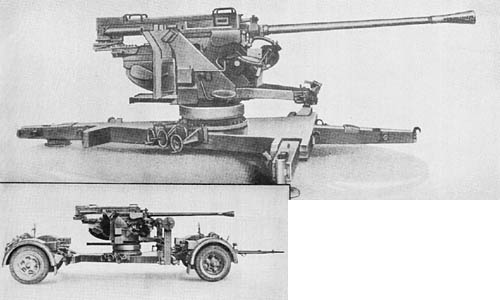
This gas-operated, automatic, antiaircraft gun is transported on two-wheeled transporters. To put the gun into action, the platform is lowered from the transporters by means of winding gear. The two transverse legs are lowered and the platform is roughly leveled with jacks. The final leveling is done with leveling screws in the base ring of the mounting. The barrel is removable for easy replacement in the field. The right hand twist of the rifling increases from one in
The breech mechanism is similar to that of the 3.7 cm Flak 43. It differs in that the breech block drops into the closed position from the open position. The dropping of the block allows buttress guides on the block to engage with similar guides on the jacket. This locks the block in the firing position and prevents any rearward movement. The feed mechanism is operated by the recoil of the breech casing. The recuperator consists of two spiral springs which are mounted side by side in the cradle. The buffer is mounted centrally in the cradle.
The traversing gear and the sight are on the right hand side of the mounting. The sight bracket is connected by means of a parallel motion link to a cross shaft. Here it is keyed to a pointer on the elevation scale. The gun elevating gear is on the left side of the mounting. This is also connected to a pointer on the elevation scale. The layer keeps the two pointers in line and the gun is laid at the same angle of elevation as the sight.
SPECIFICATIONS
| Caliber | 5 cm (1.97 ins.) | |
| Weight (traveling position) | 7.18 tons | |
| Weight (firing position) | 4.30 tons | |
| Length (traveling position) | 27 ft., 5.5 ins. | |
| Length (firing position) | 19 ft., 10 ins. | |
| Height (traveling position) | 7 ft., 1 in. | |
| Height (firing position) | 7 ft., 4 ins. | |
| Width (overall-traveling) | 7 ft., 10 ins. | |
| Width of trail spread | ||
| Length of gun (incl. muzzle brake) | 184.5 ins. | |
| Length of gun (excl. muzzle brake) | 170.8 ins. | |
| Length of rifling | 117.28 ins. | |
| No. of grooves | 20 | |
| Width of grooves | 0.160 in. | |
| Depth of grooves | 0.020 in. | |
| Width of lands | ||
| Muzzle velocity (H.E. shell) | 2,756 f/s | |
| Firing mechanism protrusion | 0.1 in. | |
| Max. range (horizontal), APCBC | 11,300 yds. | |
| Max. range (vertical), APCBC | 8,600 yds. | |
| Effective ceiling | 10,000 ft. | |
| Rate of fire | 130 r.p.m. | |
| Traverse | 360° | |
| Elevation | 90° | |
| Depression | -10° | |
| Length of recoil | 7 ins. (approx.) | |
| Ammunition | H.E. 41/tracer; Incendiary/H.E. 41/tracer; A.P.C.B.C. 42 | |
| Wt. of projectile | H.E.—4.8 lbs. | |
| A.P.—4.87 lbs. | ||
| Tracer burn out point | Short (8 sec.) 2,740-3,750 yds. | |
| Long (18 sec.) 5,400-6,120 yds. |
German: p. 125 (June 1, 1945)
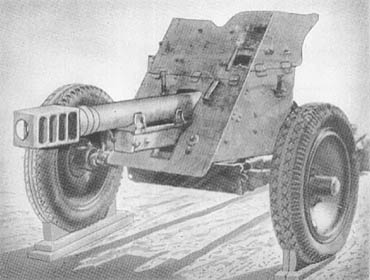
The 7.5 cm I. G. 37, formerly known as the 7.5 cm Pak 37, consists of a short barreled piece fitted with a muzzle brake, and mounted on the carriage of the obsolete 3.7 cm antitank gun. The equipment has been utilized as a close support infantry weapon.
The barrel of monobloc construction is 20 1/2 calibers long. The muzzle brake is in the shape of a rectangular box with four baffles, each at approximately a 45° angle deflecting to the rear. There is a hydrospring recoil mechanism and a breech mechanism of the vertical sliding wedge type. The latter has no provision for semi-automatic operation. A percussion type firing mechanism is cocked automatically when the breech is closed, and the gun is fired by pressing a plunger on the elevating handwheel. There is an auxiliary firing lever on the left side of the breech ring.
The carriage, which is mounted on two rubber-tired wheels, has split tubular trails. The shield is in two main parts, the upper shield and the lower shield. The lower part hinges upward when travelling, and is swung downward when the weapon is in the firing position. The upper shield is in two sections, the upper half being hinged. This section can be folded forward in order to give a lower silhouette.
Traversing, elevating, and sighting are accomplished by one man. Direct sighting is obtained by means of a telescope. A quadrant plane is located on top of the breech ring, and there is also a range drum graduated for firing semi-fixed high explosive and fixed hollow charge ammunition. With the present fire control equipment, the maximum effective range is 2,900 yards.
SPECIFICATIONS
| Caliber | 75 mm (2.95 ins.) | |
| Weight (traveling position) | ||
| Weight (firing position) | 1,124 lbs. | |
| Length (traveling position) | 11 ft., 7 ins. | |
| Length (firing position) | 11 ft., 1 in. | |
| Height (shield lowered) | 38 ins. | |
| Height (shield raised) | 46 1/4 ins. | |
| Width (overall) | 5 ft., 3 1/2 ins. | |
| Width of trail spread | 9 ft., 1 in. | |
| Length of rifling | 42 3/4 ins. | |
| Rifling | R.H. twist | |
| No. of grooves | 24 | |
| Muzzle velocity (H.E. shell) | 920 f/s* | |
| Max. range | 5,630 yds. | |
| Max. range (present fire control) | 2,900 yds. | |
| Traverse | 60° | |
| Elevation | 22 1/2° | |
| Depression | 5° | |
| Tires | Pneumatic—6.00 x 20 | |
| Length of recoil (max.) | 17 ins. | |
| Ammunition | H.E., Hollow Charge | |
| Wt. of projectile | H.E., I. Gr. 18—13.2 lbs. | |
| HE-AT, I. Gr. 38HI/A—6.6 Ibs. |
*Muzzle velocity with hollow charge ammunition is
German: p. 122.2 (May 1, 1945)
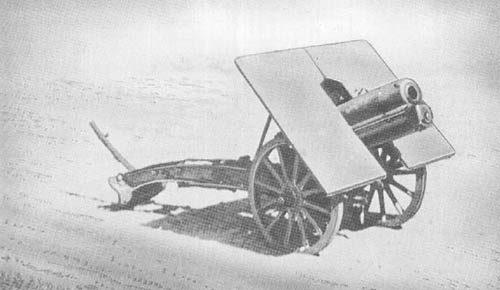
SPECIFICATIONS
| Caliber | 75 mm (2.95 ins.) | |
| Weight (traveling position) | 2,449 lbs. | |
| Weight (firing position) | 1,351 lbs. | |
| Length (traveling position) | ||
| Length (firing position) | ||
| Height (firing position) | ||
| Height of trunnions | 27.7 ins. | |
| Width of carriage | 37.4 ins. | |
| Length of bore | 13 cals. | |
| Length of barrel and breech ring | 43.8 ins. | |
| Rifling | R.H. polygroove plain section | |
| Length of rifling | 31.2 ins. | |
| No. of grooves | 28 | |
| Width of grooves | 5 mm | |
| Depth of grooves | .68 mm | |
| Width of lands | 3.5 mm | |
| Muzzle velocity (H.E. shell) | 1,270 f/s | |
| Wt. of projectile | 12 lbs. | |
| Max. range (horizontal) | 7,270 yds. | |
| Max. range (vertical) | ||
| Rate of fire | ||
| Traverse | 7° | |
| Elevation | 50° | |
| Depression | -10° | |
| Length of recoil (max.) | 35.4 ins. | |
| Ammunition | H. E. & Hollow Charge |
German: p. 122.1 (May 1, 1945)